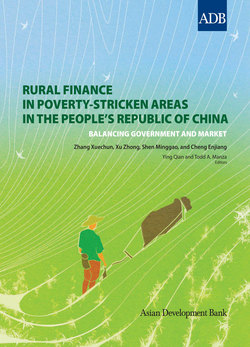Читать книгу Rural Finance in Poverty-Stricken Areas in the People's Republic of China - Xuechun Zhang - Страница 11
На сайте Литреса книга снята с продажи.
Rural Lending Shops
ОглавлениеAny institutional innovation, particularly an inductive institutional innovation, needs an enabling environment. Private enterprises in the PRC faced discrimination before booming under relaxed regulation and an improved operational environment. Presently, a friendly policy environment is encouraging the diversification of financial organizations in the PRC, and diversified real economic entities demand increasingly diverse forms of finance and financial innovation.
The new rural financial organizations are both familiar and strange for many farmers. Before the reform of the collectively owned economy in the countryside, production cooperatives, supply and marketing cooperatives, and lending shops (or credit cooperatives) were the three major cooperatives in rural areas. However, the function of these cooperatives was to prepare for the transformation to a collectively owned economy. It has become obvious that, after being stripped of distribution and/or sales and credit, production cooperatives cannot operate independently and efficiently. This is particularly true of RCCs, because such segregation severed the otherwise inherent link between production and capital allocation, artificially creating information barriers between production cooperatives and lending cooperatives and thus making it difficult to match capital allocation with production demand. Emerging production cooperatives (also known as rural special technique associations or the companyplus-farmer model) successfully link production and the market, and rural lending shops represent a model that connects supply, sales, production, and credit.
Private enterprises in the PRC faced discrimination before booming under relaxed regulation and an improved operational environment
Rural lending shops can help address, at low cost, issues that are costly for formal financial institutions such as credit cooperatives. The purpose of merging Baixin Rural Lending Shop and Baixin Farmers’ Cooperative in Jilin Province, for example, is to provide funds for the farmers’ cooperative. Though the two cooperatives have their own names, they are one entity; the farmers’ cooperative provides the lending shop with a platform to raise funds. Members of the farmers’ cooperative have detailed knowledge of members’ funding needs, integrity, repayment ability, and capital source for loan repayment (e.g., income from sheep sales). Such knowledge helps address information asymmetry and simplifies loan assessment.
In addition, the farmers’ cooperative is an institutional arrangement through which borrowers may repay loans. If a member intentionally defaults, the farmers’ cooperative may deduct the proceeds of a member’s sales to repay the loan or may terminate his or her membership. Because all members live in the same or adjacent communities, peer pressure subjects the defaulting member to sanction in every aspect of production and life. Such punishments prevent borrowers from defaulting, and loans are repaid on time even in the absence of collateral, litigation, government intervention, or other means.
One advantage of informal institutional arrangements is their low cost, which makes it possible to meet even the smallest demand for credit
Initially, lending shops were an informal institutional arrangement that relied mainly on interpersonal trust, local culture, folk customs, and personal acquaintance. Such informal institutional arrangements are difficult to regulate through word and contracts, making them unofficial and informal, as opposed to laws and regulations. One advantage of informal institutional arrangements is their low cost, which makes it possible to meet even the smallest demand for credit. In addition, informal institutional arrangements may be exempt from the regulatory and other types of examinations required in formal institutional arrangements. Of course, informal institutional arrangements also are subject to constraints, such as difficulty in accessing legal and administrative assistance in case of disputes. In this sense, lending shops are similar to private lending organizations.
The risks faced by lending shops are similar to those faced by farmers’ cooperatives. Lending shops are generally small, with strong homogeneity, meaning that similar productive or operational risks affect a large number of their members. Baixin Rural Lending Shop, for example, would suffer large numbers of defaults or even go bankrupt in the event of plague or other disease, or if market prices fluctuated, and its self-rescue ability is weak.
Thus, institutional innovations are needed to forestall the risks related to lending shops. In the beginning, government has an important role to play. First, the size of lending shops must be rigorously restricted to ensure that financing occurs only among members. Second, productive and operational risks must be diversified. For example, farmers’ cooperatives may cooperate with the government, insurance companies, and disease prevention and quarantine agencies to prevent the spread of plague. Governments can subsidize some insurance premiums and can encourage the insurance sector to create insurance products tailored to local needs. Disease prevention agencies can share partial risks or benefits through holding a stake in the form of technology. Third, a risk fund can be established with interest income and partially subsidized by governments. Finally, a loan guaranty fund can be created to compensate for losses from natural disasters or accidents beyond human control.
In addition to the adoption of institutional innovations to diversify risks, rural financial institutions also should put in place innovations to reduce operational and transaction costs, especially in far-flung and sparsely populated areas. Rural financial organizations may reduce transaction costs by adopting informal financial approaches, creating an all-around operation that covers rural finance, postal savings offices, and farming material sales. They can also learn from international experience in introducing technologies such as mobile phone banking.
